
A bit of light can be found in Recoleta Cemetery even on the darkest & rainiest of days. To see others in this series, search for “reflection” in the sidebar.
Leave a Comment
A bit of light can be found in Recoleta Cemetery even on the darkest & rainiest of days. To see others in this series, search for “reflection” in the sidebar.
Leave a Comment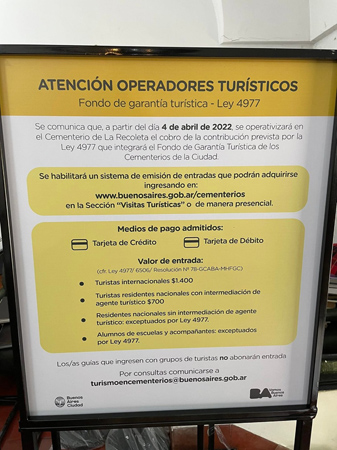
In 2015, we wrote about a possible entrance fee being established for Recoleta Cemetery. The idea was shelved, then COVID hit in 2020 & the cemetery closed to tourists for almost two years. But as of April 4th —with very little advance notice— the Buenos Aires city government will charge foreigners 1400 pesos (at this time almost 13 USD) to visit what is still declared by Law 4977 as a public space.
A Clarín article from 30 Mar 2022 by Karina Niebla states that income generated will be used for maintaining all cemeteries in Buenos Aires (for example: renovating the pantheon in Flores, restoring niches in Chacarita & reinforcing security in Recoleta). Let’s hope so. Still, we can’t help but wonder why is the entrance fee so expensive or why a public space is being privatized.
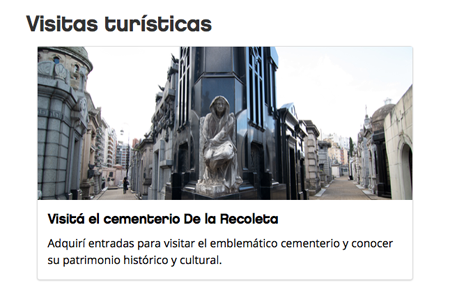
Another problem the city government failed to address is that tour operators that have already sold packages including a cemetery visit must absorb this extra cost until the fee can be incorporated into future services. This argument halted implementation of an entrance fee in 2015 & still remains valid. With no grace period or temporary exemption, tour companies must take yet another cut in income after two years of almost no clients at all. We’ll have to wait & see how the situation unfolds.
Residents of Argentina can enter for free, except if they visit on a guided tour… then they must pay 700 pesos (currently a bit over 6 USD). Guides are exempt from the entrance fee, but at some point all cemetery guides will have to participate in a training course given at the cemetery. We’re all for that!
The online ticketing system seems straightforward enough, but authorities have cut two hours from visiting time. Recoleta Cemetery opens at 07:00, but visitors cannot enter until 09:00. Sneaky & a shame since those early hours have incredible light from the sunrise. Clicking through various screens generates an electronic ticket as shown below:
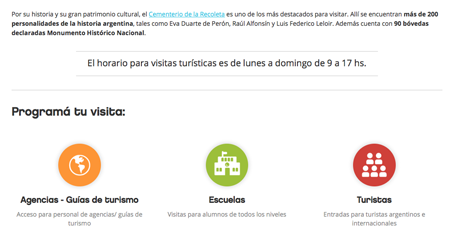
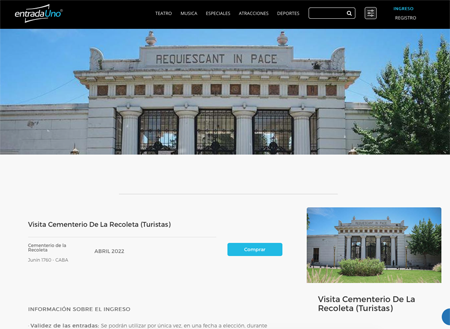
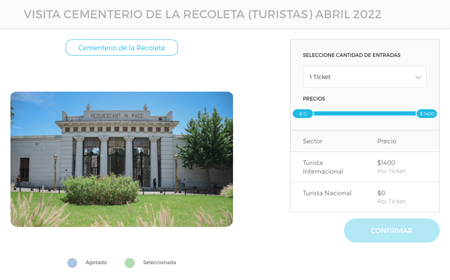
Tickets are only available online. Our Recoleta Cemetery PDF guidebook will be updated soon with this new information & links to pre-purchase tickets.
Update (01 Oct 2023): As of today, the official price of a ticket to Recoleta Cemetery has “increased” to 3768 pesos from its original value listed above. While the amount in local currency has gone up, in terms of USD the price has actually decreased since tickets were first established due to Argentina’s rampant inflation. With the current official exchange rate at 365,50 pesos per USD, the ticket price now sits at $10.31. Expect this value to continue to vary until inflation is brought under control… probably not any time in the foreseeable future.
Update (Jan 2024): That last price increase did not last long! But the newest price hike to 5090 pesos isn’t surprising given recent elections & even more inflation. With the current official exchange rate at 819 pesos per USD, the ticket price is now about $6.20. We’ll try to stay on top of this rollercoaster.
Update (Dec 2024): Time to stop this ride 😉 There’s no way we can keep up with all the price increases, so this will be the last update for the post. The sidebar will always display the entrance fee which currently costs 16,100 pesos or almost $16 USD. Seems a bit expensive, pero es lo que hay.
5 Comments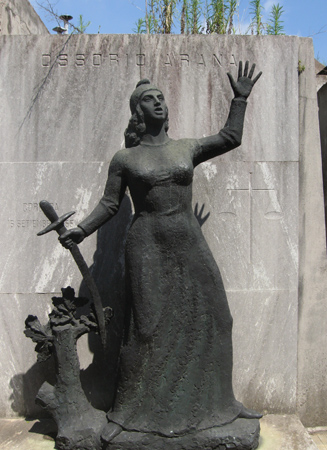
Born in the western outskirts of Buenos Aires in 1902, Arturo Ossorio Arana embarked on a military career that would lead him to participate in several military coups. Staunchly anti-peronista, he would also be complicit in hiding Eva Perón’s embalmed corpse… proof that friends & enemies rest side by side in Recoleta Cemetery.
In 1951, the Minister of the Army blamed Ossorio Arana for leading a group of young officers in a revolt against the Perón government. Relieved from duty, he tried to oust Perón again in 1955 with help from Pedro Aramburu & Eduardo Lonardi. Resulting civilian casualties were high after rogue military planes bombed Plaza de Mayo. However, Perón had been tipped off & took refuge in army headquarters just in time. A few months later, the military finally succeeded in taking control & attempted to wipe all traces of Peronism from Argentina.
As part of that plan, Ossorio Arana held the deceased Eva Perón captive for a while… but you’ll have to get the map/guidebook for that story! In the end, Ossorio Arana was more known for re-establishing martial law as Commander-in-Chief under Aramburu’s de facto presidency. In 1956, he gave permission to execute by firing squad a group of young people who had opposed the military government. Seven of 12 people shot would survive & later become immortalized in Rodolfo Walsh’s Operación Massacre.
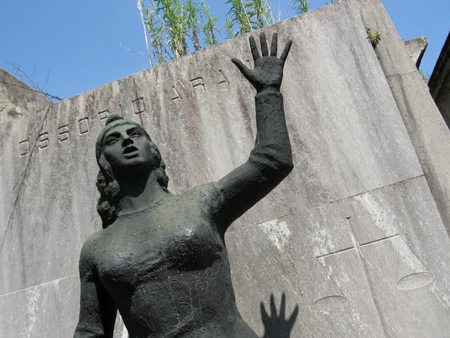
The tomb of Ossorio Arana is striking with its gigantic, oversized statue of Argentina. A brilliant work by sculptor José Fioravanti, she represents Liberty with her sword ready for action. Ossorio Arana died in Buenos Aires in 1967, but the place & date on his tomb —Córdoba, 16 Sep 1955— correspond to the revolution that forced Perón to flee Argentina. Engraved scales represent Ossorio Arana’s belief in military justice.
His funeral drew a large crowd, with a multitude of military speakers & a large escort. La Nación reported that a couple people were arrested for public disturbance… one even shouting “Long live democracy!” Big thanks to Nicolás Colombo for sending us the images below… he runs the Misterios de La Plata blog & Facebook group.
Given his control over national affairs, memorials (like the one shown below) were common for several years after Ossorio Arana’s death. On the first anniversary, former President Aramburu gave a speech that was later engraved on the left side of the tomb:
“…If you fear the risks of Liberty, If you find safety in the obedience that despots impose… Do not stand before the tomb of this soldier!”
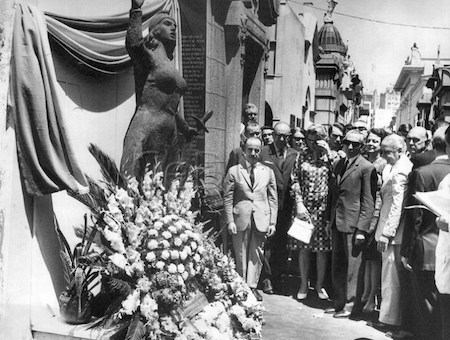

What a stunning statue of an angel gazing towards the heavens by Luigi Trinchero. Invited to Argentina by fellow Italian artist Victor de Pol in 1889, Trinchero directed a ceramics factory in La Plata that ultimately did not succeed. Soon after its closure, he returned to Italy.
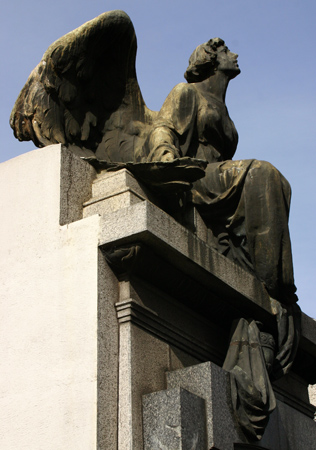
However, Trinchero came back to Argentina at the insistence of Carlos Morra & this time would succeed. He established a workshop to produce ornamental sculpture… exactly what Buenos Aires needed as many aristocratic porteños rekindled their European origins & a building boom began. Trinchero decorated the Centro Naval, churches, schools & most famously the Teatro Colón.
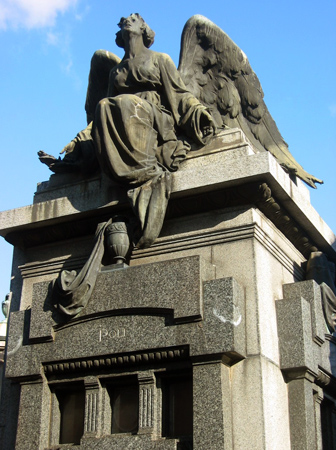
A descendant of Antonio Riva has generously shared his family history with us. A portion of his comment is copied here. Thanks, Agustín!
5 CommentsAntonio Riva, whose name is featured on top of the mausoleum’s door is my great great grandfather. He was a wealthy Genovese born (who came to Argentina maybe in the 1860s) importer and salesman of food stocks in the late 19th and the early 20th century. He probably commissioned the sculpture from Trinchero at the same time the sculptor was famous for doing work in the Teatro Colon in Buenos Aires. The rest of the mausoleum was most likely built by other Italian workers who more or less made these in series, albeit really well. Antonio Riva’s daughter, Emma Riva, who was fond of art and Italian artists – sponsoring painters such as Angel Della Valle – was maybe involved in picking the sculptor for the mausoleum. Emma Riva married Giulio Poli, and that is why the surname Poli was added.
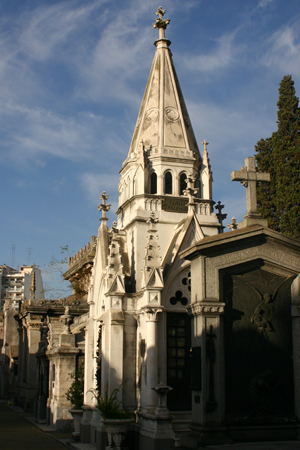
Born in Buenos Aires in 1815, Juan Andrés Gelly y Obes had a high-ranking diplomat & lawyer for a father. His family emigrated from Paraguay to Argentina for political reasons, & after the birth of Juan Andrés they had to move to Montevideo in 1830. Father & son fought side by side against the relentless sieges of Rosas. Those early struggles no doubt inspired Gelly y Obes to enlist in the Argentine Legion at the age of 24.
Although reaching the rank of Lt. Coronel, Montevideo would later lose all its appeal: his father moved to Brazil & his mother died after being near a grenade explosion while visiting his position. He considered joining his father & returning to Paraguay, but in the end became a politician/military man in Buenos Aires. A long friendship with Bartolomé Mitre, begun in Montevideo, influenced his career for the rest of his life.
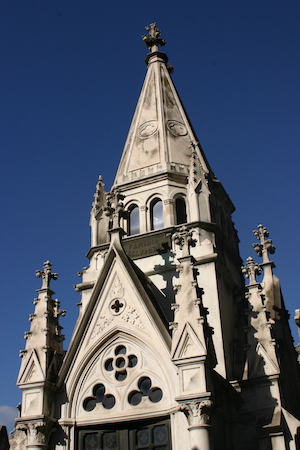
During Mitre’s presidency, Gelly y Obes was named Minister of the Army & Navy but resigned to lead troops in person during the War of the Triple Alliance. When Argentine forces began to sack Asunción, he stepped down based on family connections there; some Paraguayans even wanted him to be their next President. In the end, he continued service in Congress in Buenos Aires & was reinstated in the military in 1877… to be removed again in 1880 after participating in a revolution with Mitre. Amazingly, this pattern would repeat itself when Julio Argentino Roca reinstated Gelly y Obes only to be dismissed again after supporting the Revolución del Parque in 1890.
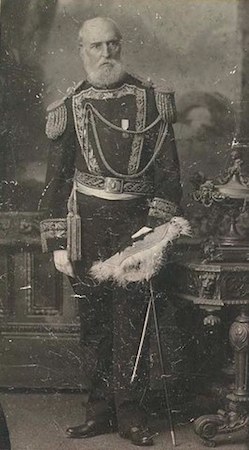
Later reinstated, Gelly y Obes served on Argentina’s top military council & supported the modernization of the military under General Pablo Riccheri. He passed away in 1904 at the age of 89 after a lifetime of service with no equal other than perhaps that of his friend Mitre! This Neogothic mausoleum sits near the rear wall of the cemetery & declared a National Historic Monument in 1946.
Leave a Comment